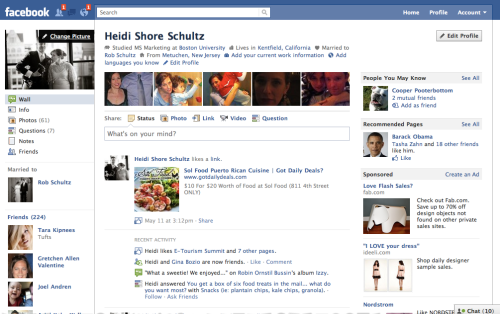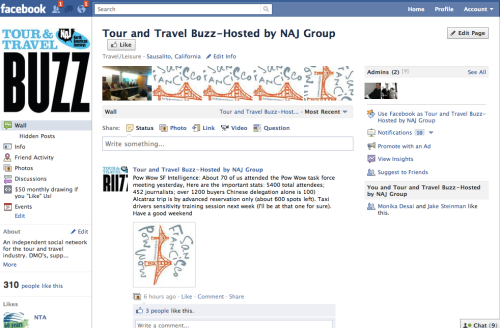Facebook Profiles, Pages & Groups. What should I choose? How do I keep my personal info separate from my company info?
If you are reading this you probably have a Facebook “Profile.” (To be sure go to your Facebook account. If you have a list of Friends, you definitely have a Profile.) This allows you to communicate with friends, family and colleagues. If you wish to promote a commercial entity you should create a Facebook “Page.” If you have a group of your Facebook Friends that you want to keep in touch with, i.e. old college friends, you should create a Facebook “Group.” Remember, you must have a Facebook Profile before you can create a Group or a Page. If you have any questions after you read below please feel free to post your question on our Tour & Travel Buzz Facebook page!
The table below summarizes the differences between profiles, groups and pages and the screen shots beneath the table provide a visual reference.
|
AT-A-GLANCE COMPARISON: “PROFILE” vs “GROUP” vs “PAGE” |
|||
| FACEBOOK “PROFILE” | GROUP | “PAGE” | |
| Who administers? | Have one administrator: you. | May have multiple admins, as arbitrarily appointed by creator or the admins. | May have multiple admins, which are appointed authorities of the business. |
|
Who’s Represented? |
Represent a real person. | With the exception of copyrighted material or hate speech, represent anything. | Represent a real business, celebrity or promotional entity. |
| Confirmations | Have friends. Friendships need to be confirmed by both parties. Only friends can see private information. | Have members. Member requests may be reviewed or automatic, depending on the group’s settings. | Have fans (aka people who “like” your Page) Fan requests are automatically approved. The available information is the same for everyone. |
| Send & Receive messages | Can send messages to other people, and up to 20 friends. If people are friends they can always message each other. | Permit admins to send messages up to 500 members. Members can reply to the Group admin. | Allow admins to send bulk messages to all fans. People cannot reply to these messages and can opt out of them. |
| Who can see what? | The person behind the profile may make choices about what, if anything, is globally visible. | Can restrict privacy to members or opt to be globally visible. | Can restrict privacy based on age, but are otherwise always globally available. |
| Approval process | Must approve all friend requests. | May choose to review membership requests or accept automatically. | Automatically accept all fan requests. |
| Blocking Capabilities | Can block people for inappropriate behavior. | Can block people for inappropriate behavior. | Can block people for inappropriate behavior. |
| Tracking and analytics | Have no access to analysis about page views and interaction. | Have no access to analysis about the page views and interactions with the Group. | Have detailed insights about how people view and interact with a particular Facebook Page. |
| Limitations | 5000 friends and/or Pages they “like” combined. Beyond that FB will remove. | Unlimited, but chat disabled for a Group that goes above 250 members. An individual can join up to 300 Groups. | There is no limit to the number of fans a page can have. |
| SEO Capabilities | Option to be visible by search engines. | Not visible by search engines. | Visible by search engines. |
Facebook Profile Example:
A profile is for an individual and you may only have one profile. Once you have created your profile you can become friends with people, post on your wall and also on a friend’s wall, post pictures and information about yourself, join groups, like Pages, chat, send and receive private messages. You are able to set privacy levels that determine how much of your information you are willing to share with different people and groups. Your profile is limited to 5000 friends. You can create a business page, create and/or join Groups and purchase advertising.
Facebook Group Example:
This is a Group of former colleagues from a company called JuniorNet. The members use the group to plan meet ups and reminisce about old times. You can see the Group has 70 members. All members can post and the other members are notified. Members can have live chat and create a shared document that all members have access to. They may use the shared document to make a list of the members and what food items each will bring to a planned event.
Facebook Page Example:
This is the Tour & Travel Buzz Page. You can see right under the name of the page there is a “Like” button. Once you hit that button any posts the Page makes will appear in your newsfeed when you are logged into Facebook. On the left hand column you can see the Page has 310 “Likes.” That is the total number of people who have agreed to receive updates from this Page. In the right hand column you will see “Admins.” There are two pictures there because there are two people authorized to manage this Page.




